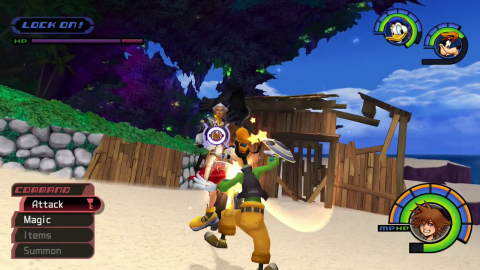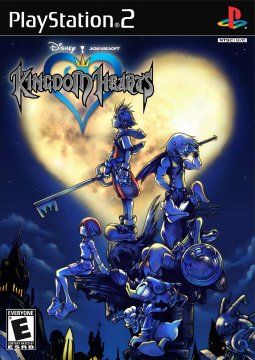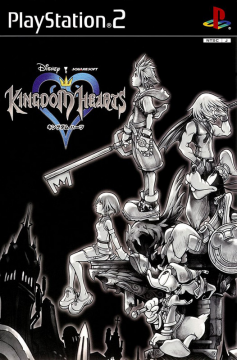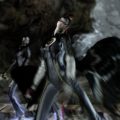- Kingdom Hearts
- Kingdom Hearts: Chain of Memories
- Kingdom Hearts II
- Kingdom Hearts: 358/2 Days
- Kingdom Hearts: Birth By Sleep
- Kingdom Hearts Re:coded
- Kingdom Hearts: Dream Drop Distance
- Kingdom Hearts χ
- Kingdom Hearts 0.2 Birth By Sleep
- Kingdom Hearts III
- Kingdom Hearts: Melody of Memory
- Kingdom Hearts (Miscellaneous)
In the early 2000s, Square was just about revving up what would prove to be a whole decade of spinoffs and sequels to their tent-pole Final Fantasy franchise. One such spinoff attempted to turn their turn-based RPG franchise into an action-RPG: the unusual but forever memorable Kingdom Hearts (another early attempt in this lane was Final Fantasy Crystal Chronicles, released under the merged Square Enix the next year). A crossover from out of the blue, Kingdom Hearts used familiar Final Fantasy mechanics, but set them inside the worlds of Walt Disney’s animated features. The real-world story behind this corporate crossover has been told in a dozen contradictory ways, throwing doubt onto any individual telling, but what matters is that the two companies got to talking and agreed to wild crossover product, which set sail in 2002.
Kingdom Hearts‘ anime-style storyline has built up a reputation as unnecessarily complicated, but the core premise is easy enough to digest. Sora, an eager and friendly island boy, is swept up by supernatural forces, where he discovers the universe is made up of hundreds of worlds, each just large enough to, say, host a Disney film! While Disney gets the settings and plots, Final Fantasy gets familiar spells and RPG development, and maybe the odd cameo, like Cloud Strife from Final Fantasy VII showing up in the world of Disney’s Hercules. Whatever the game, some evil is afoot, and Sora generally pairs with Donald Duck, done up as a wizard, and Goofy, a knight who only fights with his shield, to save the day. Sora himself uses a magical, key-shaped sword called a “Keyblade,” with the power to undo any lock, and has a loose definition of what “lock” really means, ranging from the lock on a treasure chest to the emotional locks on the human heart. The “Kingdom Hearts” of the title is an ill-defined, central plot device, which frequently takes the shape of a heart-shaped moon.
Kingdom Hearts games are also known for their complicated version history. The games mirror a release schedule sometimes seen in Square’s other product lines: first a Japanese version, then an enhanced version for international audiences, and then a return to Japan for a full-prize re-release with even more bonus features. In Kingdom Hearts, this third version is typically called Final Mix. These Final Mix releases generally didn’t see release outside of Japan until the 2013-17 HD collections, and even some of these got a new iteration when the collections were ported to eighth generation consoles and PC.
Kingdom Hearts‘ cast contains legions, so these cast lists will attempt to focus on only the absolute tip of the character iceberg.
Characters
Sora
Your typical teenaged shounen protagonist, whose empathy frequently outsteps his brains, especially in later titles. Sora is the keystone that holds the others together, the heart of the squad, the light of their lives, and other puns this series would appreciate.
Riku
Sora’s best friend and rival. In Kingdom Hearts 1, Riku ends up mixed up with Disney villains and even fights against Sora for a while. His later games are half about redemption, and half about finding strength his personal “darkness”.
Kairi
Sora and Riku’s best friend. Introduced as a damsel in distress, Kairi has spent most of the series as little more than a (prominent!) prop in other people’s story arcs, a problem that’s only started to turn around… maybe. She seems nice enough.
Donald and Goofy
Speaking of characters with limited development, Donald and Goofy are Sora’s new best friends. They’re fun to have around, and the story is definitely better with someone for Sora to play off of, but they are who’ve they’ve been since the 1930s, aren’t about to dazzle you with character growth any time soon.
Maleficent
The dark fairy from Disney’s Sleeping Beauty, Maleficent’s blatant evil makes her a constant and fun antagonist for the series. Unfortunately, she has a bad habit of getting overshadowed (and often defeated) by the games’ main antagonists.
Ansem, Seeker of Darkness
Introduced as a researcher looking into the problem of evil itself, the player eventually learns Ansem’s research was genuine, but his motives less than noble. The actual story, like so many things in Kingdom Hearts, is complicated, but it suffices to say that this anime-styled villain serves as the main antagonist of the first game.
The plot of the first Kingdom Hearts game doesn’t stray far from the core structure described above. A horde of shadowy beings called “the Heartless” (named after some cheeky wordplay that required them to be named “Heartless” even in the Japanese versions), shadow demons that vary from comical to horrifying, have invaded the worlds at the behest of the evil Maleficent. When they destroy Sora’s homeworld, Maleficent snaps up Riku as her protégé and the two friends come to blows in a quest to find the missing Kairi.
The game begins on a dream-like opening tutorial that actually doubles as a character creation sequence. The player’s stat and skill gain, as well as the rate at which they gain levels, are all decided here, disguised behind questions about which weapon they’d prefer or even an eerie personality quiz. Unfortunately, these options aren’t very well balanced. Taking the sword during the weapon section makes for a much easier game than taking the magic staff, and if the personality quiz declares you’ll “start your journey at night,” that will leave you high and dry for EXP for the first half of the campaign, and Kingdom Hearts has a tough early campaign!
Compared to later games in the series, Kingdom Hearts feels heavy and slow, though those limitations allow it to host involved puzzle sequences and secrets that would feel out of place in speedier entries in the series. Metroid-style puzzles that require the player to come back with later upgrades are everywhere, and the game’s secrets have filled many an internet FAQ. Like Final Fantasy Crystal Chronicles, the developers have you interact with the world via an RPG-style command menu, allowing Sora to swap between Attacks, Magic, Items, and other commands, but only in the slowest way possible. It’s very easy to end up in a dicey situation without the Attack command, so the whole system takes some practice. Only a few button shortcuts exist for magic spells, though the HD ports took the lead from later games in the series by consolidating certain functions to the Triangle button. Unfortunately, the PS2 game uses the shoulder buttons for camera control (the only console game in the series that does), which wasn’t moved to the right stick until the HD release.
Sora’s attacks are just as slow as the rest of the game, making combat feel more deliberate and arguably more tactical than its follow-ups, but also clunky. Magic follows suit: cheap, quick-fire spells, named after the traditional Final Fantasy Fire and Blizzard elements, sit alongside slow-acting and costly Thunder and Gravity spells that have to be employed carefully. Sora doesn’t regain magic very fast, at least not without the MP Rage ability, and that might come very late in the game depending on character creation! Later in the game, Sora can also call on Disney cameos as Final Fantasy-style Summons, though few are useful.
Once Sora has met up with his new duck and dog buddies, they’ll fight alongside him, with occasional help from Disney locals. Your friends are good at distracting the Heartless, but are infamously empty-headed when it comes to items and magic, which is bad news for Donald. While you can and should adjust their AI in the menu, your options are limited, and do nothing to stop them from smashing your entire potion supply on the first scraped knee. It’s best to never give them any items at all, even if this will leave Donald, and indeed Sora, running on empty.
After you clear the first two worlds, Sora and the player are set loose on a map of the solar system, stuffed full of Disney worlds with their own unique gimmicks to help keep play interesting. Aladdin gives you a tightly-packed set of areas with movement traps, while Hercules provides the game’s arena world, host to all sorts of tournaments. The Alice in Wonderland and the Nightmare Before Christmas worlds function on their own weird logic, making puzzles experimental but also totally arbitrary. Easily the most drastic world is the one for The Little Mermaid, which the player spends transformed into a mer-dolphin, using a completely distinct set of swimming controls. The swimming controls generally aren’t well-regarded, marking the world as a low-point for many players.
At any given point in the story, the player is allowed to select from one of three worlds, each sorted by a difficulty rating. While most players will play in that order, the game goes to lengths to account for your relative freedom, composing alternate cutscenes for all sorts of variant situations, something later games would leave by the wayside.
While travelling between worlds, the player is treated to a ride in the “Gummi Ship,” a ship made out of sticky blocks that can be fully customized, though the customizer is confusing. Gummi Ship flights are inspired by Star Fox: a tunnel-like rail shooter through rudimentary environments that hardly would have been out of place on the Super FX chip, but look way too sparse for a PS2 game!
The game has plenty of other distractions. There’s an entire, optional world full of minigames starring the cast of Disney’s animated Winnie the Pooh productions, while a game-wide sidequest involves the 101 Dalmatians. Most post-game play is centered in the Hercules tournaments. Once that’s wrapped, the game has several post-game bosses, though the exact bosses available depends on the version. International versions and later a grueling battle with Final Fantasy VII’s Sephiroth, while Final Mix players can fight the series’ first “Unknown,” a boss in a black coat that foreshadows a later release. Clearing some of these challenges can earn you a stylish concept trailer for Kingdom Hearts 2.
A lot of Kingdom Hearts‘ quality comes from its presentation. The music from Yoko Shimomura is legendary, and the game leads off with a dream-like music video set to a pop song by Utada (who would return with new singles for Kingdom Hearts 2 and 3). Every world is bright and colorful, and its characters resemble the Disney originals quite nicely, helped along by the assistance of Disney’s voice stable, including original voice actors when still available. The game also wasn’t afraid to be experimental and weird at times, like aging down Tidus and Wakka from Final Fantasy X and Selphie from Final Fantasy VIII, so they can be Sora’s childhood friends!
Unfortunately, one level of technology wasn’t up to the task of emulating Disney: facial animations. Like other games of the era, Kingdom Hearts can only do full facial animation with higher-res models during cutscenes, and most of the time, faces are just decals on a smooth, doll-like surface. The pointed appearance of the standard gameplay models gave rise to the insult, “fish-faces,” among the fandom. Even though facial expression tech would pick up starting in Kingdom Hearts 2, fish-faces wouldn’t be banished until Kingdom Hearts 3, seventeen years later.
For the PS1/PS2 era, Square typically made updated re-releases of their games with extra content, typically stuff that was added for international localizations plus extra elements. Many of these were only released in Japan. Kingdom Hearts: Final Mix is one of these, which made a few overhauls to the experience. The most prominent change was that the developers recolored every “Emblem Heartless” in the game. Japanese players were also given the opportunity to play English voiceovers, which was important for fans who may have grown up with subtitled, English Disney films! The game was also rebalanced, primarily by adjusting the order the player receives skills. It also added new puzzle enemies that are required targets to synthesize the game’s best items.
In 2013, Kingdom Hearts was given an HD port as part of the Kingdom Hearts HD 1.5 ReMix collection on the PlayStation 3, later released on the PS4 and on Windows, which includes the Final Mix content. Beyond the higher resolution visuals, revised character models based on Kingdom Hearts 3D: Dream Drop Distance, and assorted control tweaks, it runs in widescreen at 60 FPS. The Nintendo Switch version is a streaming “cloud” release, which is unfortunate considering that the HD versions of the game were originally created for the PlayStation 3, so it should be strong enough to handle it.




